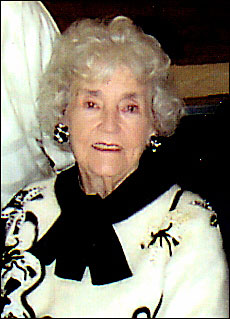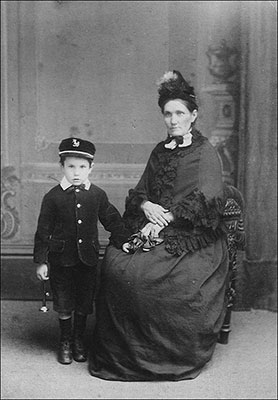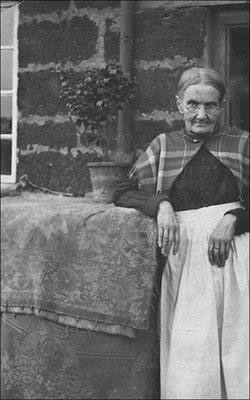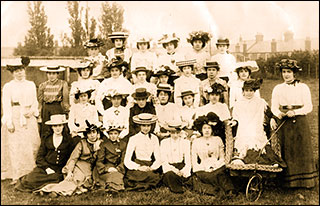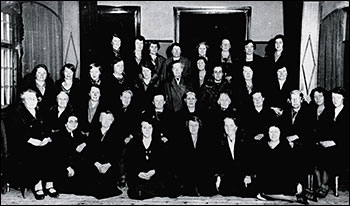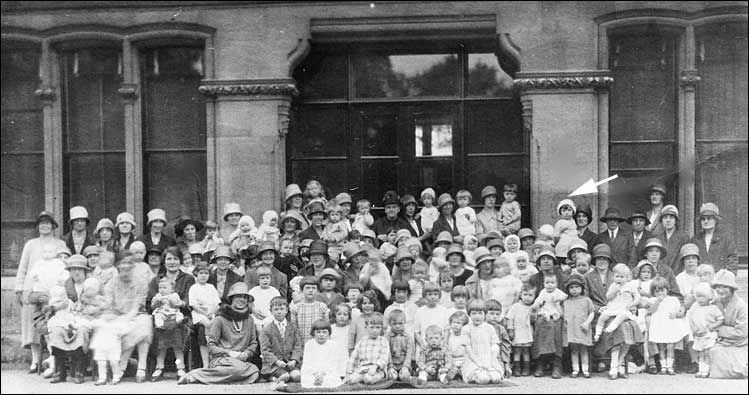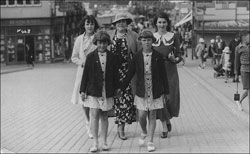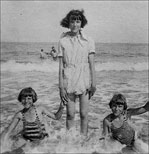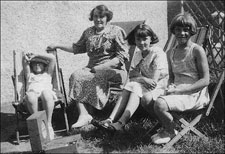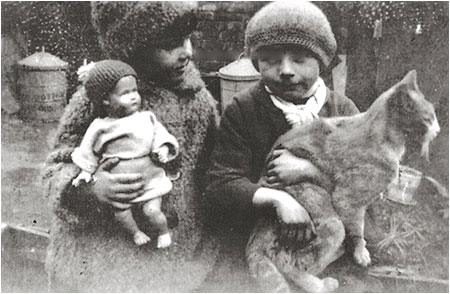| Prepared and presented by Margaret Craddock following an interview recorded on 4 December 2007 |
||||||||||||||||||||||
|
||||||||||||||||||||||
|
||||||||||||||||||||||
|
Background "I lived there for about 25 years and then moved to 190 High Street and from there to 44 High Street and then to 15 Finedon Road. I was married in 1953 and have one daughter, Lorraine, two grandchildren and a great granddaughter. My mother, Grace, was born in South Africa and I don’t know where father, Frederick, was born – I should imagine he was born in a little cottage up Piggotts Lane because I’ve got a photograph of him with my grandmother, Rhoda Jane, who came from Grafton Underwood. He’s a little boy in a sailor suit and she looks too darned old to be his mother but that’s how they used to dress. He looked so young. He was the youngest you see of a big family. He spent his life in Burton Latimer. I had two sisters and two brothers and I was the youngest. We’ll start from the top, Irene, Clifford, Phyllis, Douglas and then me. Cliff died when he was only 25 when he had been playing cricket one week and died the next. Phyllis died in 1967 and Douglas was killed in Italy during the 2nd World War. Rene (Irene) lived to be about 86. My father was a clicker in the shoe factory but I don’t know which one. He died when I was 7 years old. My mother worked in a shoe factory. They were both in the shoe trade.
"I went into the clothing industry and then a bit later on in my life I went into the Coles shoe factory. I was an under-edge trimmer. My sister, Rene, worked on the samples and when she retired I took over. Schooldays "I went to Finedon Road Infants School and then I went to the Church School. I can’t remember much about the Infants School. I’ve just got one prize I won. I think it was for good conduct – it's got the three bears on the front. Miss Wallace, I think, was the headmistress, Daisy Wallace. I can’t remember any of the children from that school. "At the Church School the teachers were Miss Mabel Lewis (Edith), Mr Mitchell from Raunds, Lottie Watson, Miss Roberts – she was Welsh. Mr Cook was another teacher. He was a tall man. I remember him giving a boy named Baish the cane. They should bring that back now. I went to school there with Doris Lowe, Joan Sharp, Doreen Bailey, Daphne Eady, Roland Winkle, Roy Clipson, Ray Basford, Ron Gazeley and Elsie Parkinson. Elsie Parkinson was a very good friend of mine. She came here with a lot of children of her age. I think they must have come from a depressed area. I don’t know where they came from. She was lodging with a Mr and Mrs Lewis whose daughter lived in Alexander Street and died only a few years ago. Elsie Parkinson - I would love to get in touch with her, I wonder if she is still alive. When I had a new bicycle – it was a big thing then. My dear mother she hadn’t got a lot of money. Elsie had my old bicycle. She lived in Isham with her foster parents. Quite a lot of boys and girls came down at that time because there were a lot of depressed areas but I don’t actually know. If Evelyn, Mrs Lewis’s daughter, was still alive she could have told us. At school, milk started. The Ministry of Health I think was Walter Elliott and we could have milk, a little bottle, and it was five pence a bottle and then it went down to twopence halfpenny. There were only two of us had it in our class and then it was just me because I think the other lady liked Meads milk and it was Co-op. "Another girl in my class, Connie Hancock, her mother was a cripple. She lived in Windmill Cottages and she used to get her mother all ready before she went to school and then get back. She never had any leisure at all that girl. There was no help, she used to dress her mother before she went to school. I used to think what a life for her and eventually she went into a home. I think that she died when she was about 21. Her father used to go to the Baptist Church, worked on the railways and died about 10 years ago. "I had my ears pierced whilst I was at school. That caused quite a stir. I remember George Talbutt asking me why I had them done so I said that I had older sisters who were very modern and fashionable and it was them who said about it. I used to suffer with a stye on my eye. It didn’t affect my sight but they weren’t very nice. Somebody suggested having my ears pierced. I did – and I didn’t have any more styes. That was really the reason and I only wore little earrings so that no-one would ever notice. It wasn’t the done thing then for a schoolgirl to have her ears pierced. I remember George Talbutt looking a bit grim. "We used to play netball at school and when we went for cooking lessons we had to come down to the Council School. I can’t remember playing many games but we used to have races and things like that but I wasn’t very good at it. Wartime "It was very hard in wartime. I felt it because I lost a brother. Then there was rationing and all that business but we overcame it didn’t we? Blackouts! I can always remember my two friends, Kath Lewis and Joyce Mason, they came to see me soon after it had been announced that we were at war. I can see them now. I looked out of my bedroom window, I think, and I saw them coming up the street. They’d got their gasmasks on their backs. I can see it now, you know, I didn’t bother with mine. "I left school when I was 14 and I went straight into the clothing factory. I didn’t get asked what I wanted to do. My mother knew the Manager at the factory and she said “I’ve got a job for you and you can start.” It wouldn’t do now. I didn’t earn a lot to start with. You didn’t start on a machine directly. You took tackings out, you got a stilleto and took all the tackings out and then you got on a machine. I’ll tell you who used to teach us, a big churchgoer, Violet Haddon. Oh dear, we did have some laughs. I still do on the phone with Joyce when I ring her up and talk about these times. Leisure "At this time I was working at the Co-op Clothing in Pioneer Avenue/Station Road. We used to go dancing mostly in Kettering. It was the Kingsthorpe Hall down Russell Street. We went to the Central Hall but that was later. We started off with Old Tyme. I often wonder about my friend and I, Joyce, we must have gone on the bus, mustn’t we. We didn’t walk, we didn’t go on bikes. It was safe for us to go there but it wouldn’t be today, would it? We used to go down there for Old Tyme dancing and a Mr & Mrs Crook took the lead and they were Spiritualists and lived in Ensleigh Close. They used to take the lead in all the dancing and we used to follow suit. It was rather tame but then we got on to bigger things, more modern dances as we got older. We had quite an enjoyable time. Functions are still held down there and the room still gets booked. I think the Mind charity go there. The room is still active. We had dances up the Cons and a few at the Britt. That’s all I think. That’s all the rooms there were. They used to have the dances to pick the carnival queen at the Conservative Club. I can remember that. "I used to like sewing when I was young, needlework. I used to make chair backs, I’ve still got one somewhere. I used to put everything into it. I liked the back to look nearly as good as the front. Outings "When I was a schoolgirl I didn’t travel very well. My dear mother wanted me to have a broader outlook and she belonged to the Kettering Co-op Women’s Guild and they used to have outings. I always remember going to Cadbury’s Bournville factory. It upset me you see and it upset mother and everybody around us as soon as I got on the train. I couldn’t eat the chocolate. It was an eye opener, I can always remember it. It was a big thing then. There weren’t many, I can’t ever remember anybody telling me that they went to anything like that. Mother used to want to take me out to show me things. Broaden my outlook. Dear Grace. "I used to go on holiday to my aunt, Aunt Til, at Leicester – Matilda. I used to go there and spend holidays with her. She had a house at Mablethorpe and we went there with her grandchildren, Rhoda and Freda.
Sunday School and Church "I went to Sunday School at the Church School. My teachers were Gwen Fox, Rene Tompkins and Phyllis Booth. I have since had Church kneelers made for them. It was in the morning but I used to attend the Mission Room with my mother Sunday night for the Sunday service and I always remember sitting at the back, near a cupboard with some holes in the front. There was a chap keeping us all in order but I can’t think of his name. He lived just over the road and his wife was in the choir and he used to keep his eye on the boys. I remember seeing one once having a clip of the ear but they wouldn’t be able to do that now, would they? They would be in trouble. They’d be at the Magistrate’s Court. I stopped going to Church altogether until I got older. Years elapsed before I went again but one Sunday when I lived in the High Street I heard the church bells ringing and I thought ‘Joan you never go, it’s time you did’, so I started going and I’ve been going ever since. That would be from the 70’s I think. It was the bells ringing that did it. I thought ‘Gosh there’s some people there ringing the bells for me’, and I thought it was a bit selfish of me so I’ve been supporting them ever since. Still doing it. I remember the church bazaars but I didn’t take part in anything like that but there were some good workers you know, like Edie Darby and those sort of people. They gave all their time and effort to the church. There was Mrs Tailby from the Yews, she was in a class at school with my mother. She always wanted the top parts. I have a photograph of her with my mother. George Talbutt’s on it. Shops "I remember the old Co-op shops in the town, up Duke Street. There were furnishings up Duke Street, a shop. They used to do slaughtering up there too. The Co-op was very thriving then. Of course, I was brought up to be a Co-operator – a socialist. I still like to go to the Co-op but I wouldn’t say I’m a socialist now. I used to go to Brown’s shop for my sweets in Alexander Street. I used to think the place was haunted. You used to go in and the bell used to ring and it used to be ages before the old lady came from out the back. She didn’t look very clean but they used to sell sweets, so that’s where I would go. Over the road at night it was fish and chips there, Mrs Cooper, I can see her now dishing them out. They were very nice. We used to like the fish and chips round there. Further along there were a sweet shop, Stokes’s, at the top of Lover’s Walk. I used to go there once a week for about 2 pennyworth of Radiance toffees. I used to think it were lovely. I used to go to Mabel Piper’s with my friend, Nellie Desborough. We didn’t shop at Mabel’s because we had all our stuff from the Co-op. It used to be delivered. We used to run down there. The Desborough’s were a big family, and I can see Mabel now cutting the cheese for Nellie and potted meat. She’d got a dish of this potted meat. When we got outside Nellie would open the package and nibble a bit of the cheese for herself but never give me a bit. Poor Nellie she died many years ago. That’s how I can remember Mabel and I can see her mother too serving in there, her name was Mrs Kilburn. She was very prim and proper. She used to wear a nice little dress and it had a little bit of lace around the collar like old people did, you know. Her hair was pulled back and she was so polite and well mannered. I didn’t know if it was a long dress as she was always behind the counter. Walter was always busy at the back making coffins. That’s where Daphne, the daughter, used to practise out there. What a shame, I wonder if she is still alive. She was a churchgoer and the church should have done something about it. Mrs Curry once took me to Duston to see Daphne. I think that she had a very unhappy life, she was very restricted in what she did. She was so talented with her music.
Door to Door "We used to have tradespeople come around to the door. One man specially he was a Commercial Traveller and used to come regularly once a month. Mother used to buy a few things off him because he was so polite. Goodness knows where he came from. He wouldn’t come in a car would he? Probably he came on the train. He was ever such a nice man. He brought dusters and kitchenware, brushes. He had a great big case. Then we used to have, on a Friday night, the Trade Union man came around – Boot and Shoe. We had Co-op bread and Co-op milk and Co-op coal. My mother only wanted the best coal. She didn’t want the rubbish. I can see that being delivered now. Transport
"We used to go to Kettering on Timpson’s buses and it was Frost’s before them. They were connected with Douglas Ashby. Timpsons used to live at the top of Finedon Street. They had a bit of ground on the right. There were two girls, Joan Timpson and a younger one. I think the buses just ran to Kettering. They were blue buses. I didn’t go in the other direction to Finedon or Wellingborough when I was a child. I used to get out a bit because my grandmother had got a car but it was one of those cars where two of you had to sit outside. I used to stand at the top of the entry hoping that they were going to take me. Sometimes they did and sometimes they didn’t. I had a special coat made – an astrakhan coat – for the winter and a hat. I used to love it and we used to go somewhere where the Hickmans were. He worked on the railway and I always remember she used to make wine. I don’t know where the village were. It were full of those yellow flowers, cowslips, that you make wine with. My grandmother used to pick them. I used to love the trips out there but I didn’t go every week just when they wanted me. I used to sit outside in my coat and hat and used to think it was lovely. It were in those days. We’re talking about the 20’s. We used to go on the train but I don’t know if it was from Burton or Kettering. If only I had asked my mother a few more questions! Health "The medical facilities at the time were not very good. I can remember when we used to have parades in aid of the hospital. All the money went to the hospital. I wasn’t happy about one of the Burton doctors because when my brother was taken ill he could have done more. My mother couldn’t face the doctor but sent the neighbour, Mrs Clarke, to tell him that he had passed away. I remember Nurse Brookes. She used to take her two great big dogs everywhere. She’d got a cheek taking two dogs, everybody doesn’t like dogs. A good lady in the ambulance world was Mrs Summerfield and there was another tall lady who talked a lot and laughed a lot. Roger Saddington’s mother was also a very good ambulance lady. Reflections "In comparison to my younger days, everything is so easy now. We take everything for granted. Things were so hard. Do you know when I switch a light on, I think thank God for that. Years ago our grandmothers hadn’t got that facility. I used to go up and see my grandmother and she’d got an oil lamp and to a child that was so dull and dismal so when we had the electric light I thought we were in heaven and I still do. I can’t remember when we had it initially but we had it at home in Newman Street. It must have come on in the early 30’s probably. "People were more friendly in my younger days and more neighbourly. There are still good neighbours but its not the same, you can live next door to someone now and not even know their name because they go to work in a car. They get out, go in, and that’s how it goes and you don’t see anyone. Times are different. People were much poorer but I think that they were happier. Life was richer when I think about my childhood and all the neighbours. My mother was very good she used to befriend anybody who was less fortunate. She always brought me up to say that if anybody at school was not so well off as you then you should always treat them with respect as they can’t help their upbringing. That’s what I used to do at school. Conclusion "We take everything for granted now and everything comes so easy, technology is all advanced. Are we happy with it? Now I am living in sheltered accommodation in Yeomans Court and I’m quite comfortable. I don’t watch much television because it’s all a load of rubbish. I don’t watch any soaps but I like programmes that are going to broaden my mind, like visiting countries that I haven’t been to and never likely to go to now. I am a bit better informed through those sort of programmes. I’ve never wanted to move from Burton, I’ve stayed put. I’m quite happy as I am in my old age." |
||||||||||||||||||||||
